
Return to spider life cycle

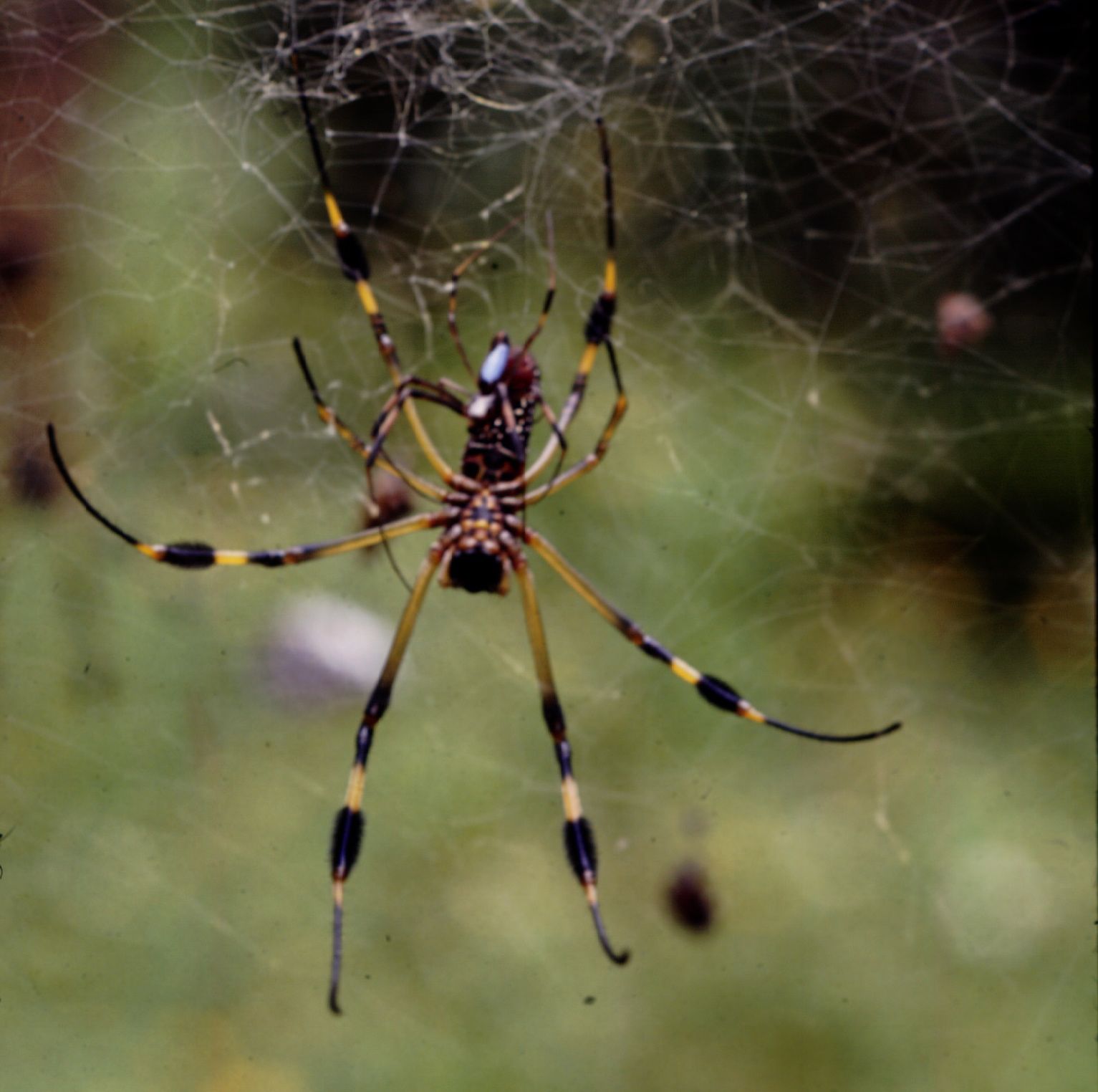 With the amount a Nephila
spider grows at each molt being fixed (not changing much with the
amount of food or other environmental conditions; see Growth by molting page), the number
of times the spider molts tells us both how old it is and how big it is
when it matures. And in Nephila,
the
number
of times each individual molts is very dependent on whether
it is male or female.
With the amount a Nephila
spider grows at each molt being fixed (not changing much with the
amount of food or other environmental conditions; see Growth by molting page), the number
of times the spider molts tells us both how old it is and how big it is
when it matures. And in Nephila,
the
number
of times each individual molts is very dependent on whether
it is male or female.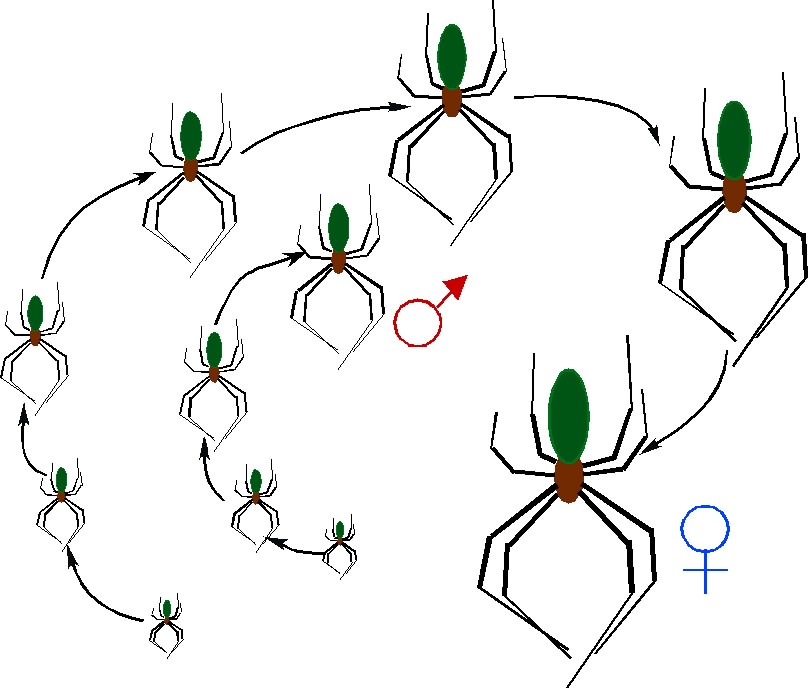
Male Nephila clavipes reared in the laboratory start out indistinguishable from their sisters. They are the same size as babies, build webs, eat flies, and grow by molting. But after somewhere between 4 and 6 molts, they reach sexual maturity and never grow again.
In contrast, their sisters continue molting - up
In this picture, a mature female N. pilipes rests on my hand - she weighed over 6 grams, more than many hummingbirds.
 Sexual size dimorphism (SSD) is
the phenomenon where males and females are drastically different in
size. As mammals, this is familiar to us in the pattern of males
being larger
than females. Because of the mammalian perspective of biologists, this
was for a long time viewed as being "normal."
Sexual size dimorphism (SSD) is
the phenomenon where males and females are drastically different in
size. As mammals, this is familiar to us in the pattern of males
being larger
than females. Because of the mammalian perspective of biologists, this
was for a long time viewed as being "normal."But when we look at animals that are not mammals, we find that in the vast majority of species, females are larger than males (among vertebrates, the most famous are the deep-sea angler fish, where males are reduced to minature external parasites of the females).
The Nephila spiders exhibit the
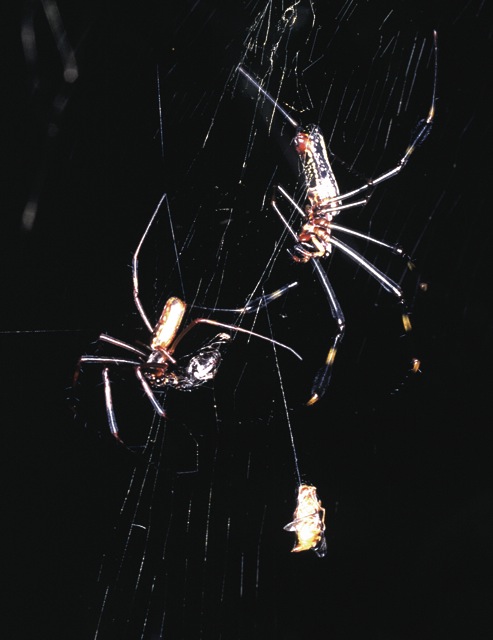 most extreme sexual size dimorphism of any terrestrial animal.
Although males are not parastically attached to females, they are
dependent upon them as kleptoparasites:
males
loose
the ability to spin sticky silk when they mature, and must
steal prey from a female. Only males that find a tolerant female will
survive.
most extreme sexual size dimorphism of any terrestrial animal.
Although males are not parastically attached to females, they are
dependent upon them as kleptoparasites:
males
loose
the ability to spin sticky silk when they mature, and must
steal prey from a female. Only males that find a tolerant female will
survive. In this photo, the male on
the left has stolen a prey item from the small juvenile female.
photo courtesy of M. Kuntner
photo courtesy of M. Kuntner
Size matters. Darwin in 1871 proposed that large females are favored through a form of selection he termed "fecundity" selection: larger females can lay more eggs. In Nephila species I've studied, larger females lay many more eggs than smaller females - the figures below show my data for N. pilipes (left) and N. clavipes (right). Bigger spiders (measured by the length of one of the leg segments) lay many more eggs than smaller spiders, supporting Darwin's hypothesis. (That big spider on my hand is the upper-most point in the left-hand graph).
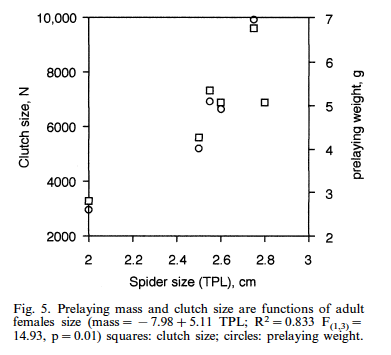
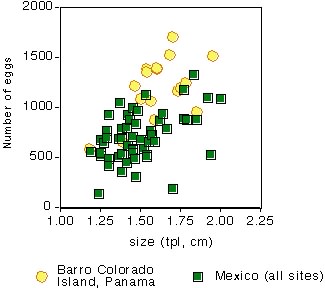
If you look carefully at these figures, you can see that the X and Y axes are very different: the smallest N. pilipes (left) is bigger than most N. clavipes (right), and lays proportionaly more eggs. Within each species, the largest females are one or two molts larger than the smallest females. Yet our best measure of evolutionary success – the number of eggs laid – increases when a female delays maturing by going through additional molts. Why, if getting bigger is so advantageous, should any female mature at a small size?
The price of delay. In a nutshell the answer to this question is that there is an end to all good things, and in Mexico this is the end of the growing season. Nephila clavipes populations live in habitats with definite changes in rainfall and temperature. Spiders caught by the shift in seasons die. How does this alter their size? We can use a graphical model to predict changes in development.
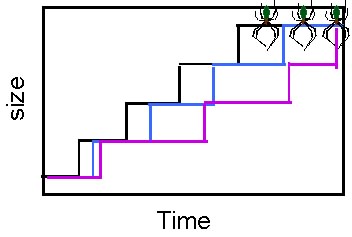 So if every spider grows the same amount each time it
molts (the steps up), but the amount of food determines the time
between molts (the horizontal lines), then spiders getting different
amounts of food will mature at different times. So long as the
weather is nice, there is no problem.
So if every spider grows the same amount each time it
molts (the steps up), but the amount of food determines the time
between molts (the horizontal lines), then spiders getting different
amounts of food will mature at different times. So long as the
weather is nice, there is no problem. 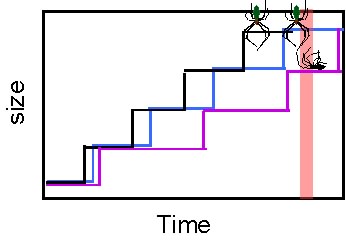 But if the spiders are living someplace where the
weather is really different between the
summer (growing) and winter (dormant) seasons, then the slowly-growing
spiders might be in trouble. We can draw a vertical red line to
indicate the end of the season. The spider growing along the purple
trajectory isn't mature yet when the season ends, and she
dies.
But if the spiders are living someplace where the
weather is really different between the
summer (growing) and winter (dormant) seasons, then the slowly-growing
spiders might be in trouble. We can draw a vertical red line to
indicate the end of the season. The spider growing along the purple
trajectory isn't mature yet when the season ends, and she
dies.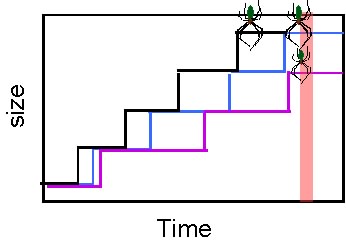 Her story has a happier ending if she has some
flexibility in how many
molts she goes through. If the spider growing along the purple line can
anticipate the coming change in season, she can molt to maturity at the
very next instar. She'll be smaller than spiders who got more
to
eat and grew faster, but she has some chance of reproducing before
the season ends. Since having some offspring is better than
none, she is more successful at this small size than if she had delayed
maturing and died without reproducing.
Her story has a happier ending if she has some
flexibility in how many
molts she goes through. If the spider growing along the purple line can
anticipate the coming change in season, she can molt to maturity at the
very next instar. She'll be smaller than spiders who got more
to
eat and grew faster, but she has some chance of reproducing before
the season ends. Since having some offspring is better than
none, she is more successful at this small size than if she had delayed
maturing and died without reproducing. Testing the model. When I looked at the size of females maturing at different times over the growing season in Mexico, the data clearly support the model of slowly-growing females making the best of a raw deal. In all sites, late females are smaller than early females. Below are the data for females from all the Mexican sites and Panama (lower right panal). Although the effects are slight, across all Mexican sites the late females are significantly smaller than earlier females. To reinforce the idea that the length of the season is important, the spiders are bigger in places with longer seasons (coastal Veracruz: Los Tuxtlas, Playa Escondida and Nanciyaga) and smaller in places with shorter seasons (Fortin, Tehuacan, Arroyo Frio, and Chamela).
This contrasts with the data from Panama, where there is no end to the growing season (although the wet and dry seasons are distinct) and there is no change over time in spider size. However, the wet season spiders capture more food, and they mature at a larger size.
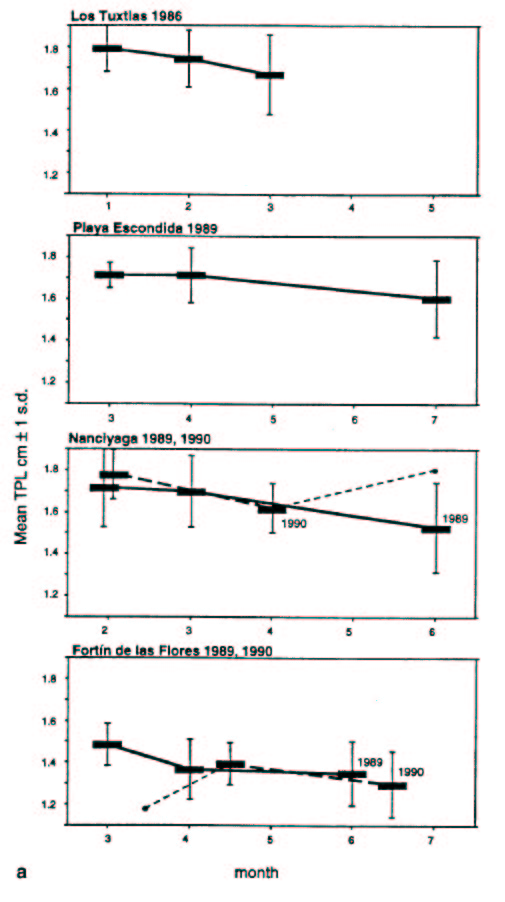
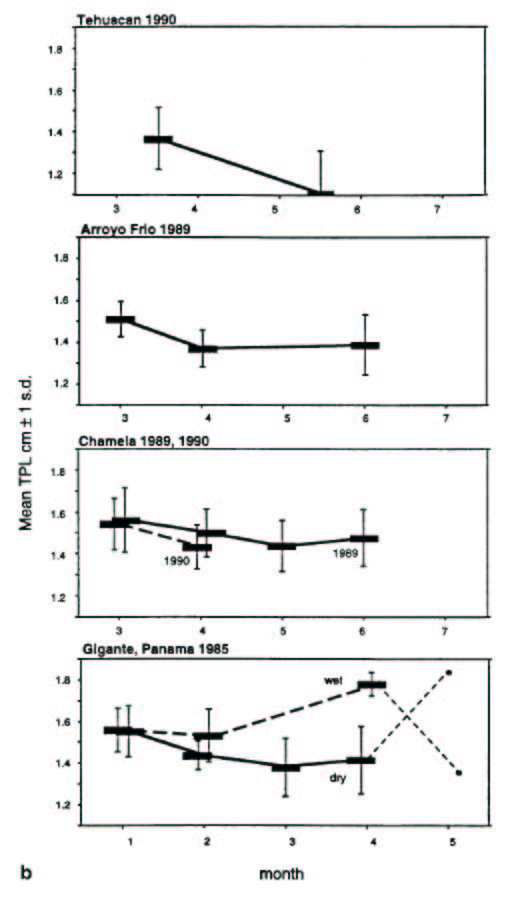
(from Higgins 2000 Oecologia 122:51-59)
 This
link
takes
you to a test of whether, across all Nephila
species, male and female
size evolve in parallel.
This
link
takes
you to a test of whether, across all Nephila
species, male and female
size evolve in parallel. (Lande 1980: Evolution 34:292-307; Slatkin 1984: Evolution 38:622-630).
 Although
we tend to always think "big is better" (particularly if, like me, you
spent a lot of time in Texas), there are costs to being huge. So
another
approach
is to consider what factors might make large size
disadvantageous. I am only beginning to explore the negative
consequences of large size, but this link takes you to my results thus
far.
Although
we tend to always think "big is better" (particularly if, like me, you
spent a lot of time in Texas), there are costs to being huge. So
another
approach
is to consider what factors might make large size
disadvantageous. I am only beginning to explore the negative
consequences of large size, but this link takes you to my results thus
far. L. Higgins. 2000 The interaction of season length and development time alters size at maturity. Oecologia 122:51-59.
L. Higgins. 2002 Female gigantism in a New Guinea population of the spider Nephila maculata. Oikos 99:377-385
L. Higgins and M. A. Rankin. 1996 Different pathways in arthropod post-embryonic development. Evolution 50:573-582
L. Higgins. 1992 Developmental plasticity and fecundity in the orb-weaving spider Nephila clavipes. Journal of Arachnology, 20:94-106